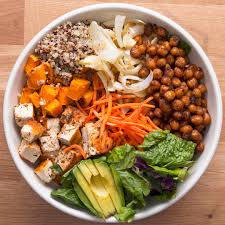 Rachel Tepper Paley
Rachel Tepper Paley
“You are one with the universe,” the Buddha bowl cooed. “You have entered a state of bliss. You have ascended to the highest levels of human consciousness, and by the way, you look absolutely stunning today.” I sighed the sigh of the self-satisfied, boosted the saturation on the iPhone photo I just snapped, and dug in.
•Organic quinoa, tempeh, fresh spinach, sauerkraut, activated almonds, fermented pickled beetroot, living sprouts and roasted pumpkin topped with red pepper hummus, probiotic cashew cheese, and ginger
Okay, that’s never happened to me. But whenever people use the words “Buddha bowl” to describe deep-rimmed dishes overflowing with vibrant food, I wonder if that’s what’s happening for them. The concept of the Buddha bowl, which appears to have hit pay dirt in late December of last year, is a favorite of yogis and health bloggers, particular those of the vegan persuasion. But what are they, exactly, apart from something I can’t stop seeing on my feed?
Martha Stewart Living offers clues in Meatless, the paean to vegetarian fare, which features a recipe for Buddha bowls. Written in 2013, it’s one of the earliest Buddha bowl references in print I could find. “With whole grains, plant proteins, and vegetables, this is the ideal vegan one-bowl dish,” claim the editors. Okay, so Buddha bowls are vegan. But the recipe continues with a caveat: “It’s more of a general formula than a hard-and-fast recipe, since you can swap out different ingredients for variety and to make use of whatever you have on hand.” Super helpful, Martha.
So I turned to Alexandra Lein, behind the hugely popular account Instagram @veggininthecity, to help me hammer out some specifics. Lein eats a Buddha bowl “for 50-60 percent of my meals,” much to the delight of her more than 75,000 followers, so I figured she knows what she’s talking about.
•Buddha Bowl with arugula, purple sweet potato, radish, cucumbers, roasted carrots, avocado, sprouts and chive
“It’s a nourishing meal that’s just little bites of everything,” Lein told me over the phone. Lein’s been eating vegan for just over two years, so obviously her bowls follow suit. Her preferred elements include a restrained portion of grain or starch (rice, barley, millet, quinoa, sweet potatoes, or corn), a smattering of protein (tofu, chickpeas, or beans), and an assortment of various vegetables, both raw and cooked. Artfully arranging the ingredients is key because, well, it looks pretty. And because a Buddha bowl doesn’t technically exist unless it’s photographed, everything is colorful (the palette may help ensure that your bowl is extra healthy. “The more varied the color in the food that you eat, the more nutrients you’re getting,” said Lein. “I like to get a little bit of orange, red, and green.”
At their core, Lein said, Buddha bowls are about “balancing the different types of food that you eat,” and not eating too much of any one thing.
Buddha bowls were starting to sound a lot like grain bowls to me, though it seems they don’t necessarily have to have a grain. Adding to my confusion, I saw that several popular blogs suggested adding lean meat to the mix. Cue vegan outrage.
So maybe there are no spoken-by-the-Buddha rules for this dish beyond general healthfulness and attractive presentation (and, of course, a bowl). There is no Buddha Bowl High Council and no whispering in the shadows about starch-to-greens ratios. And certainly there’s no evidence that Buddha bowls have much to do with Buddha, or anything religious, for that matter.
•Fresh spinach, zoodles, edamame, and zucchini ribbons, topped with a dollop of herb pesto and a sprinkle of chia seeds
To be sure, I talked to Doyal Gauranga, a monk and chef at the Bhakti Center in NYC. He told me the term was simply “another spiritual word that is taken way out of context”—in fact he’d never heard of Buddha bowls before I called. “I get sad that things are corporatized,” he said. He believes that the same thing is happening with yoga, a discipline with deeply spiritual connotations that are often ignored. “Most people don’t see that or recognize it,” Gauranga said. “They see yoga as part of their gym membership.
But, he added, with a wiseness that flowed through the telephone mic, “you can’t get angry at every little thing.” Besides, balance isn’t such a terrible concept to spread around.
“Balance is a huge part of spiritual life,” he said. “I think that having that in our diet is important, and I think it says something that people are looking for that. You can’t have a healthy spiritual life if you’re eating too much or eating too little.”
So did we learn anything here? Whether it’s a Buddha bowl, a grain bowl, or bowl of mint-chip ice cream, eat whatever makes you feel balanced and happy. And go easy on the Instagram filters, maybe.
Courtesy bonappetit.com






